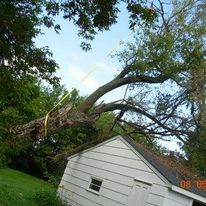Top 5 Signs Your Tree Needs Removal: Minneapolis Homeowners' Guide
- Tyler Paulson
- Apr 29
- 4 min read
Updated: May 2

As a homeowner in Minneapolis, you understand the importance of maintaining a healthy landscape. Trees not only enhance the aesthetic appeal of your property, but they also contribute to the overall health of the environment by improving air quality and providing shade.
However, aging or damaged trees can pose significant risks to your home and family. That's why it's crucial to recognize the signs that indicate a tree may need to be removed.
In this guide, we'll explore the top five signs that suggest it’s time to contact tree removal services in Minneapolis to ensure the safety and health of your property.
Sign 1: Dead or Dying Branches
Identifying Dead Branches
One of the most evident signs that a tree needs removal is the presence of dead or dying branches. Dead branches are typically characterized by their dry, brittle texture and lack of foliage.
If you notice branches that are discolored or have peeling bark, it’s a clear indication that the tree is struggling. A healthy tree will have leaves that are vibrant and full; if you see large sections without any leaves, it may be time to take action.
Risks Associated with Dead Branches
Dead branches pose serious hazards, particularly during storms or high winds, as they can fall unexpectedly and cause damage to your home or injury to people below. If left untreated, these dead branches can compromise the integrity of the entire tree.
Engaging with tree removal services in Minneapolis can help mitigate these risks and ensure your property remains safe. Arbor Solutions is a trusted provider that can assess the condition of your tree and provide expert recommendations.
Sign 2: Fungal Growth and Decay
Understanding Fungal Indicators
Fungal growth on trees is a significant red flag indicating that your tree may be decaying. Common fungi include shelf-like structures and mushrooms that grow at the base or on the trunk of the tree.
These fungi thrive on decaying wood, and their presence indicates that the tree is compromised. If you see these growths, it’s essential to investigate further, as they can weaken the tree’s structure.
Impact on Tree Stability
Decay can severely impact the stability of your tree, making it more susceptible to falling during adverse weather conditions. As a homeowner, it's crucial to prioritize safety and consult with tree removal services in Minneapolis for a thorough assessment.
Ignoring fungal growth can lead to catastrophic failures, putting your property and loved ones at risk, so don’t hesitate to reach out for a professional opinion.
Sign 3: Leaning Trees
Assessing Tree Lean
A leaning tree can be a warning sign that something is wrong. It’s important to assess whether the lean is gradual or sudden. A gradual lean may suggest root issues or soil erosion, while a sudden lean could indicate that the tree has been compromised structurally.
If your tree is leaning more than 15 degrees from vertical, it's advisable to consult with professionals who can evaluate the situation effectively.
The Safety Risks of Leaning Trees
Leaning trees can pose significant risks, especially if they are near structures or high-traffic areas. They can easily fall, leading to property damage or personal injury.
If you notice a tree leaning precariously, don't hesitate to contact tree removal services in Minneapolis to evaluate the situation. Arbor Solutions specializes in assessing the safety risks of leaning trees and can provide effective solutions.
Sign 4: Pest Infestation
Common Pests Affecting Trees
Pests can wreak havoc on trees, compromising their health and structural integrity. Common culprits include bark beetles and termites, which can weaken a tree from the inside out.
Signs of infestation include holes in the bark, sawdust around the base, and visible insects. If you notice these indicators, it’s crucial to act quickly to prevent further damage.
Long-term Effects of Infestation
The long-term effects of pest infestations can lead to decay and eventual tree failure. Infested trees not only pose risks to your property but can also affect nearby healthy trees.
Consulting with tree removal services in Minneapolis is essential to assess the extent of the damage and determine whether removal is necessary. Don’t wait for the problem to escalate; contact professionals to handle the infestation before it becomes a more significant issue.
Sign 5: Proximity to Structures
Evaluating Tree Location
Trees add beauty and value to your property, but their location matters immensely. If a tree is too close to your home, power lines, or other structures, it may pose a risk.
Look for signs that the roots are encroaching on foundations or that branches are hanging over roofs. If your tree is growing too close to these structures, it may be time to consider removal.
Prevention of Property Damage
Overgrown trees can cause damage to roofs, foundations, and landscaping. Regular evaluations of tree placement can save you from costly repairs down the line.
If you have concerns about a tree's proximity to your home, reach out to tree removal services in Minneapolis for an evaluation. Arbor Solutions can provide the guidance you need to make informed decisions about tree care and placement.
What This Means for Your Property
Recognizing the signs that a tree needs removal is crucial for maintaining the safety and integrity of your property. From dead branches to pest infestations, being proactive can save you time, money, and potential disasters.
Always consult with professionals like Arbor Solutions for an expert opinion on tree health and safety. By taking these steps, you can ensure that your landscape remains beautiful and secure for years to come. Don’t hesitate to reach out to local tree removal services in Minneapolis for a consultation and peace of mind.



Comments